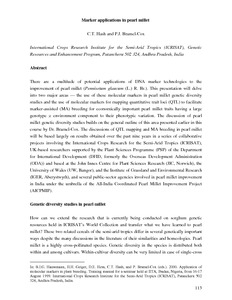Marker applications in pearl millet
Abstract
There are a multitude of potential applications of DNA marker technologies to the improvement of pearl millet (Pennisetum glaucum (L.) R. Br.). This presentation will delve into two major areas — the use of these molecular markers in pearl millet genetic diversity studies and the use of molecular markers for mapping quantitative trait loci (QTL) to facilitate marker-assisted (MA) breeding for economically important pearl millet traits having a large genotype ´ environment component to their phenotypic variation. The discussion of pearl millet genetic diversity studies builds on the general outline of this area presented earlier in this course by Dr. Bramel-Cox. The discussions of QTL mapping and MA breeding in pearl millet will be based largely on results obtained over the past nine years in a series of collaborative projects involving the International Crops Research for the Semi-Arid Tropics (ICRISAT), UK-based researchers supported by the Plant Sciences Programme (PSP) of the Department for International Development (DFID, formerly the Overseas Development Administration (ODA)) and based at the John Innes Centre for Plant Sciences Research (JIC, Norwich), the University of Wales (UW, Bangor), and the Institute of Grassland and Environmental Research (IGER, Aberystwyth), and several public-sector agencies involved in pearl millet improvement in India under the umbrella of the All-India Coordinated Pearl Millet Improvement Project (AICPMIP)

